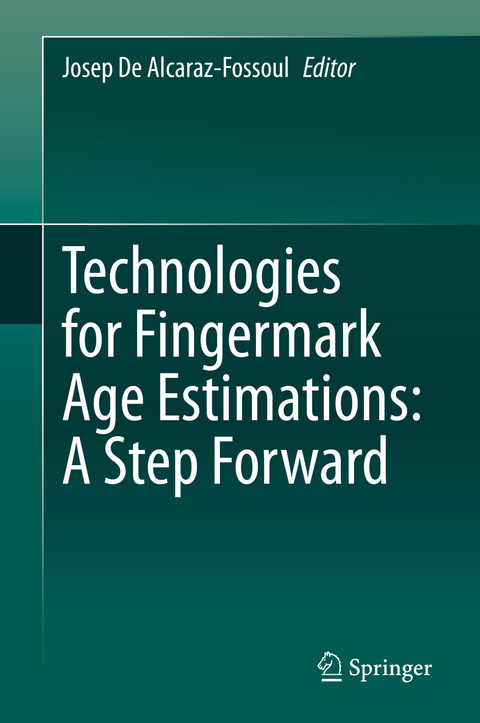
Technologies for Fingermark Age Estimations: A Step Forward
Springer International Publishing (Verlag)
978-3-030-69336-7 (ISBN)
This book discusses new applications of technologies that have been or could be successfully employed to estimate the age of fingermarks. Determining the specific time a fingermark is deposited could become a powerful new development in forensic science and a useful application to law enforcement. This book aims to shed some light on this important and still controversial area of scientific research.
The expert chapters review recent discoveries and current developments with a practical bent, focusing on prospective uses in real-world crime scenes. They take a multidisciplinary approach, featuring contributors with diverse specialties including Chemistry, Imaging Technologies, Forensic Science, Biology and Microbiology. The balanced presentation incorporates critiques on fingermark aging studies, explores the reliability of fingermarks as evidence, and discusses how the estimation of "age" can improve robustness of crime evidence. Each chapter describes a unique aspectof fingermark aging observed from a different analytical perspective: 2D imaging; 3D imaging; chemical analysis; chemical imaging; microbiome analysis; electrochemical analysis; and DNA analysis, as well as the role and application of statistics. Illustrations and graphs aid the reader in understanding the concepts being explained.
Not just a compilation of techniques and methods, this book's emphasis on practical applications and its easy-to-read style will appeal to a broad audience of scientists and criminal justice professionals alike. It will be of great interest to law enforcement, academia, and the criminal justice community; including forensic scientists, investigators, lawyers, students, and researchers. It aims to help facilitate debates in the broader community about the feasibility, convenience, and relevance of estimating the age of evidence.
Dr. Josep De Alcaraz-Fossoul earned a BSc in Microbiology at the University of Wales (Cardiff-UK) and a BSc in Biology at the University of Girona (Girona-Catalonia). This was followed by a PhD in Molecular/Vector Biology at the University of Liverpool (Liverpool-UK) and a MSc in Criminalistics at the Autonomous University of Barcelona (Barcelona-Catalonia). A Postdoctoral position at the Biomedical Research Institute of Barcelona (IRBB) was completed prior to further developing his professional career as a crime scene examiner and forensic scientist at the Catalonia Police - Mossos d'Esquadra (PG-ME).
Dr. De Alcaraz-Fossoul has taught and conducted research at Arizona State University (AZ-USA), California State University - Los Angeles (CA-USA), and the University of Barcelona (Catalonia) since 2012. He is currently an Assistant Professor of Forensic Science at the University of New Haven in Connecticut (USA). His scientific research focuses mostly on latent fingerprint aging studies by optical means (2D and 3D imaging approaches) and he also coordinates an international and multidisciplinary project on this topic. Other interests include questioned documents, including handwriting, and forensic biology.
Preface: Innovations in Fingerprint Research.- Chapter 1: Past, Present, And Future of the Forensic Use of Fingermarks.- Chapter 2: Latent Fingermarks as Complex Physical, Chemical, and Biological Structures.- Chapter 3: Estimating the Age of Fingermarks: Relevance, Potential Approaches and Perspectives.- Chapter 4: Non-Contact Technologies and Digital Approaches to (Latent) Fingermark Aging Studies.- Chapter 5: Latent Fingermark Aging in 2D: Qualitative and Quantitative Analytical Approaches.- Chapter 6: Latent Fingermark Aging in 3D: Uncovering Hidden Degradation Patterns.- Chapter 7: Latent Fingermark Aging: Chemical Degradation Over Time Amanda.- Chapter 8: New Chemical Imaging Approaches to Fingermark Dating by Mass Spectrometry.- Chapter 9: Latent Fingermarks and Electrochemistry: Possibilities for Development and Aging Studies.- Chapter 10: Latent Fingermarks and DNA Recovery.- Chapter 11: Latent Fingermarks and Microbiome: Time and Community Succession.- Chapter 12: Age Estimation of Bloodstained Fingermarks.- Chapter 13: The Application of Statistics in Fingermark Aging Research.
| Erscheinungsdatum | 17.06.2021 |
|---|---|
| Zusatzinfo | XVI, 377 p. 111 illus., 58 illus. in color. |
| Verlagsort | Cham |
| Sprache | englisch |
| Maße | 155 x 235 mm |
| Gewicht | 750 g |
| Themenwelt | Medizin / Pharmazie ► Medizinische Fachgebiete |
| Recht / Steuern ► Strafrecht ► Kriminologie | |
| Schlagworte | crime evidence reliability • crime scene investigation techniques • crime scene science tools • fingermarks age • fingermarks date • fingerprint age estimation • fingerprint analysis technologies • fingerprint evidence reliability • forensic science techniques latent prints • skin ridge patterns latent prints |
| ISBN-10 | 3-030-69336-8 / 3030693368 |
| ISBN-13 | 978-3-030-69336-7 / 9783030693367 |
| Zustand | Neuware |
| Haben Sie eine Frage zum Produkt? |
aus dem Bereich


